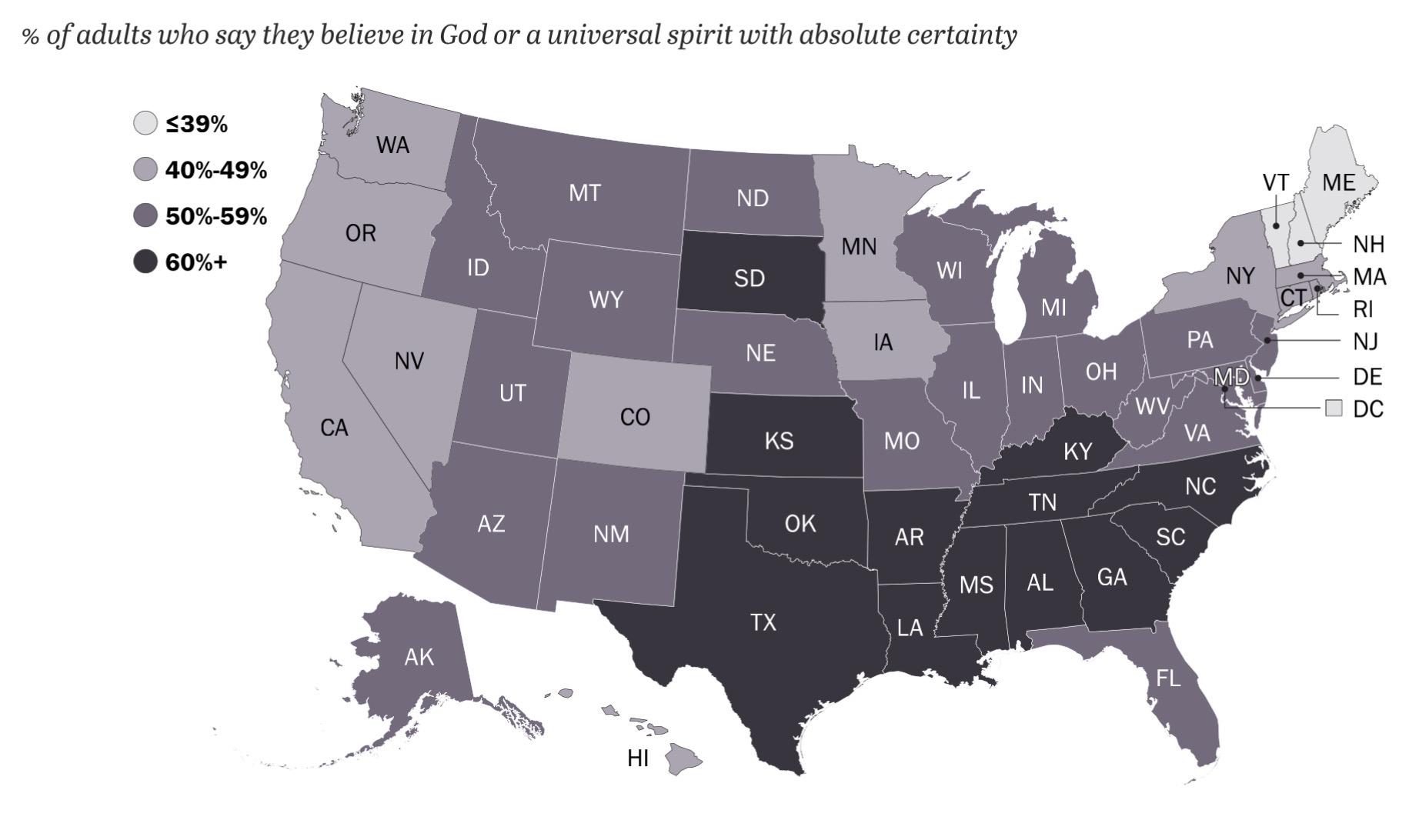Map of U.S. Adults Believing in God (2023/2024)


David Chen
Data Visualization Specialist
David Chen is an expert in transforming complex geographic datasets into compelling visual narratives. He combines his background in computer science ...
Geographic Analysis
What This Map Shows
This map visualizes the percentage of U.S. adults who claim to believe in God or a universal spirit with absolute certainty, based on data from the 2023/2024 survey. As you look at the varying shades across the states, it becomes clear that beliefs about divinity and spirituality are not uniform across the country. Instead, they reflect a tapestry of cultural, regional, and perhaps historical influences that shape how Americans view the concept of God.
Deep Dive into Belief in God
Belief in God has long been a topic of interest for sociologists, theologians, and geographers alike. In the United States, this belief varies not only by individual circumstance but also by geographical region. According to recent surveys, approximately 81% of Americans claim to have some form of belief in a higher power, but when we focus on those who assert their belief with absolute certainty, that figure drops significantly.
Interestingly, the belief in God is often influenced by factors such as education level, age, and socio-economic status. For instance, studies have shown that younger generations tend to identify as less religious than older populations. Furthermore, urban areas usually report lower percentages of absolute belief compared to rural areas, where traditional values may hold more sway.
The religious landscape of the U.S. is also marked by diversity. Christianity remains the dominant religion, but the rise of secularism, agnosticism, and atheism has been notable over the past few decades. According to a 2021 Pew Research Center study, 29% of U.S. adults identified as religiously unaffiliated, which includes atheists and agnostics. This shift has implications for how we understand community, ethics, and even politics, as belief systems often influence social attitudes.
The map not only highlights regional differences but also invites us to consider the nuances within those regions. For example, states in the South, often referred to as the "Bible Belt," show high percentages of individuals who believe in God with certainty. In contrast, northeastern states like Massachusetts and Vermont exhibit lower levels of absolute belief, pointing towards a more secular, progressive mindset prevalent in those areas.
Regional Analysis
Breaking it down by regions, the South stands out as the area where belief in God is most robust. States like Alabama and Mississippi report figures exceeding 70%, suggesting a strong cultural attachment to religious practices and beliefs. This can be attributed to a combination of historical, demographic, and cultural factors, including the legacy of evangelical Christianity, which has deep roots in these states.
Moving to the Midwest, states like Indiana and Ohio show moderate levels of certainty in belief, with figures around 50-60%. Here, a blend of urban influences and rural traditions creates a unique landscape for belief—one that often emphasizes community and family values.
In the West, particularly in states like California and Washington, the percentage of adults who believe in God with absolute certainty is considerably lower, often falling below 40%. This trend is reflective of a more diverse population that includes a significant number of individuals who identify as non-religious, as well as a growing acceptance of alternative spiritualities.
Interestingly, the Northeast presents a mixed picture. While urban centers like New York City exhibit lower levels of certainty in belief, rural areas in states like Maine can still show surprisingly strong adherence to traditional practices. This demonstrates that even within a single state, belief can be incredibly varied.
Significance and Impact
The implications of this belief landscape are profound. Understanding where and why certain beliefs persist can inform everything from social services to political strategies. For instance, in areas with high belief certainty, political platforms may lean more towards conservative values, while regions with lower certainty could embrace progressive agendas.
Moreover, the trends observed in this map may serve as a bellwether for future societal shifts. As younger generations continue to identify as less religious, we might see a transformation in community structures, social gatherings, and even local economies. This points to a future where spirituality takes on new forms, possibly moving away from traditional institutions.
In conclusion, this map not only illustrates current beliefs about God but also serves as a reflection of broader societal trends. By analyzing this data, we can gain insights into the evolving American identity, where faith, culture, and geography intertwine in complex ways. Have you noticed how these trends might influence your own community? The conversation around belief is far from over, and as demographics shift, so too will the landscape of American spirituality.
Visualization Details
- Published
- October 5, 2025
- Views
- 42
Comments
Loading comments...